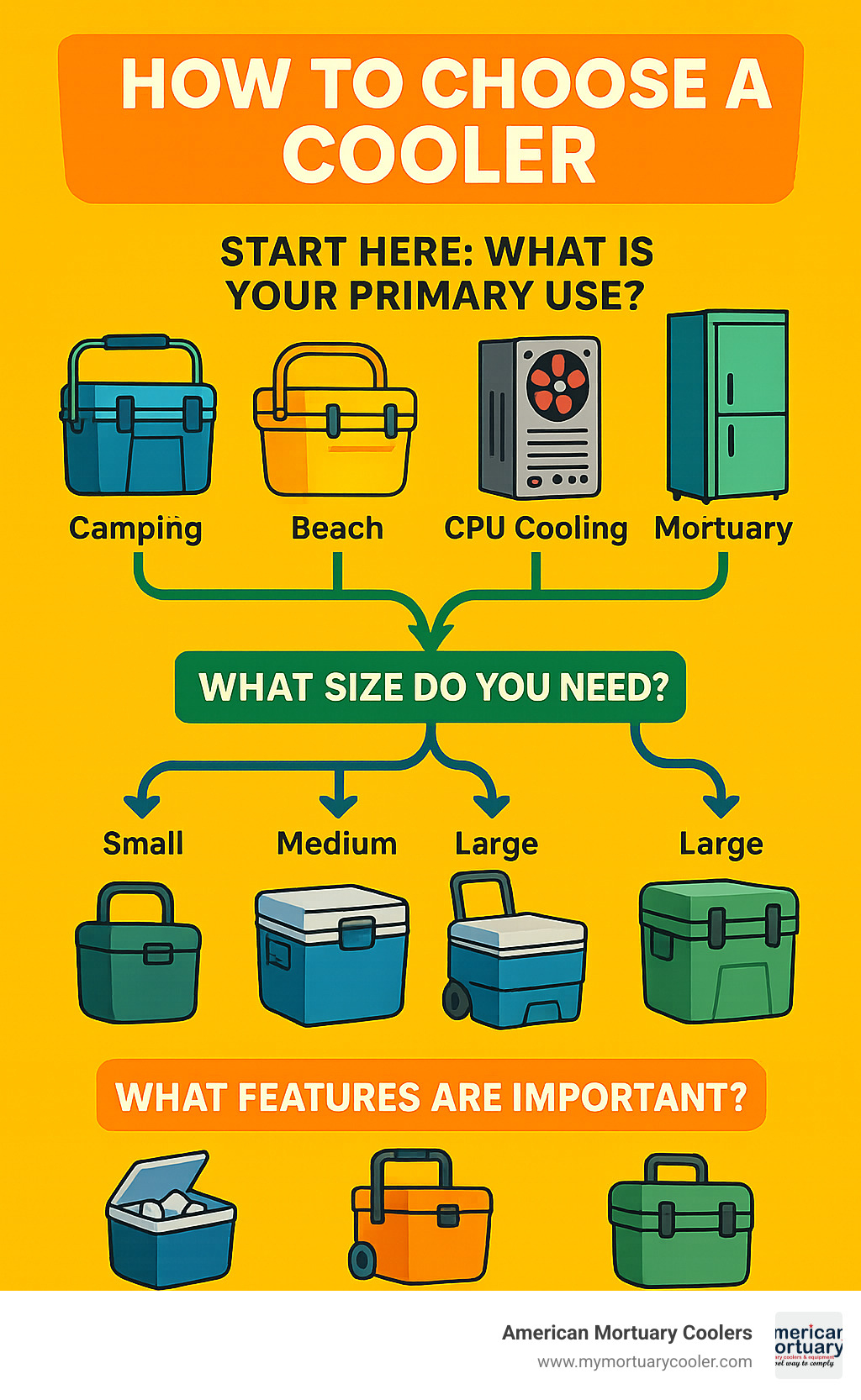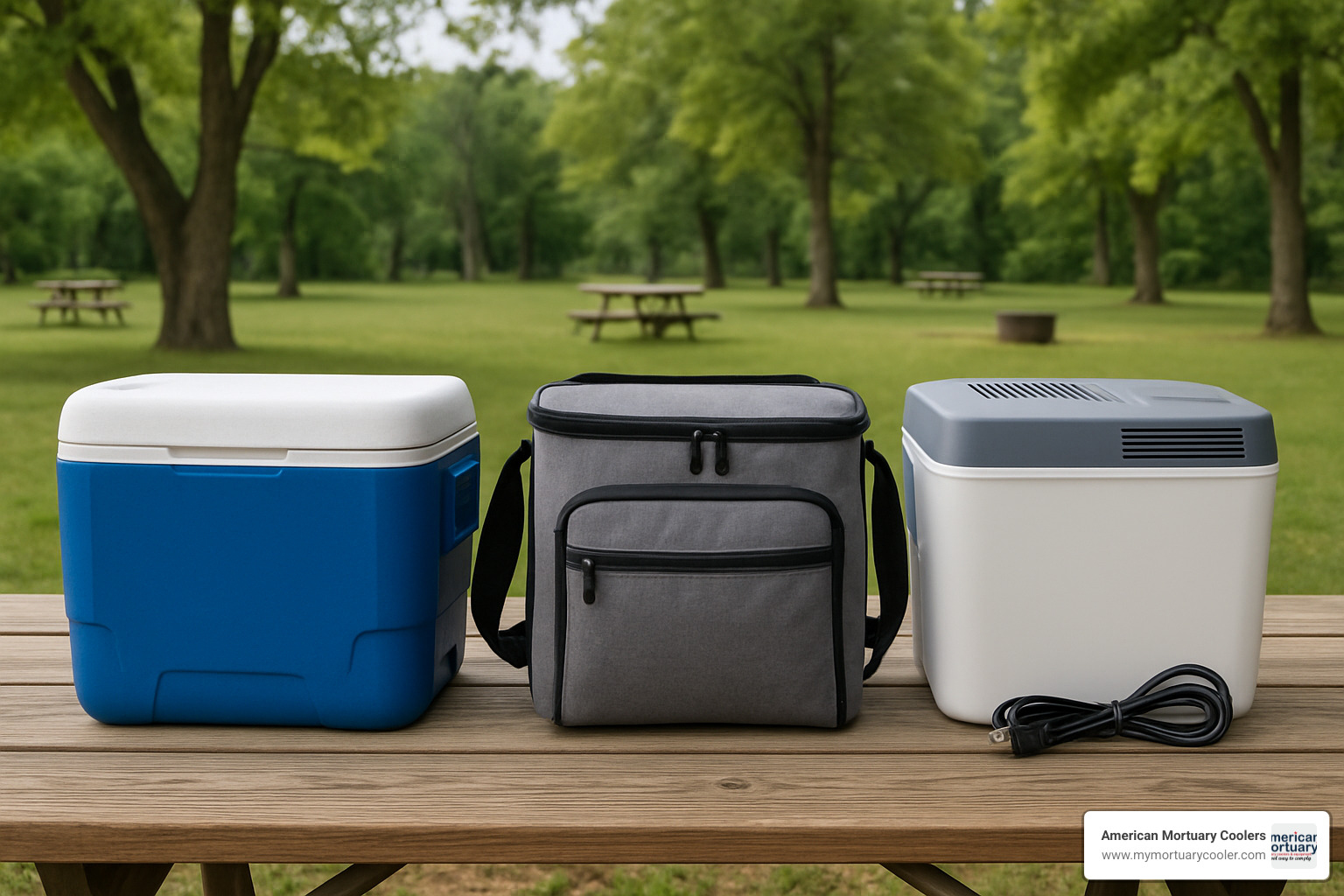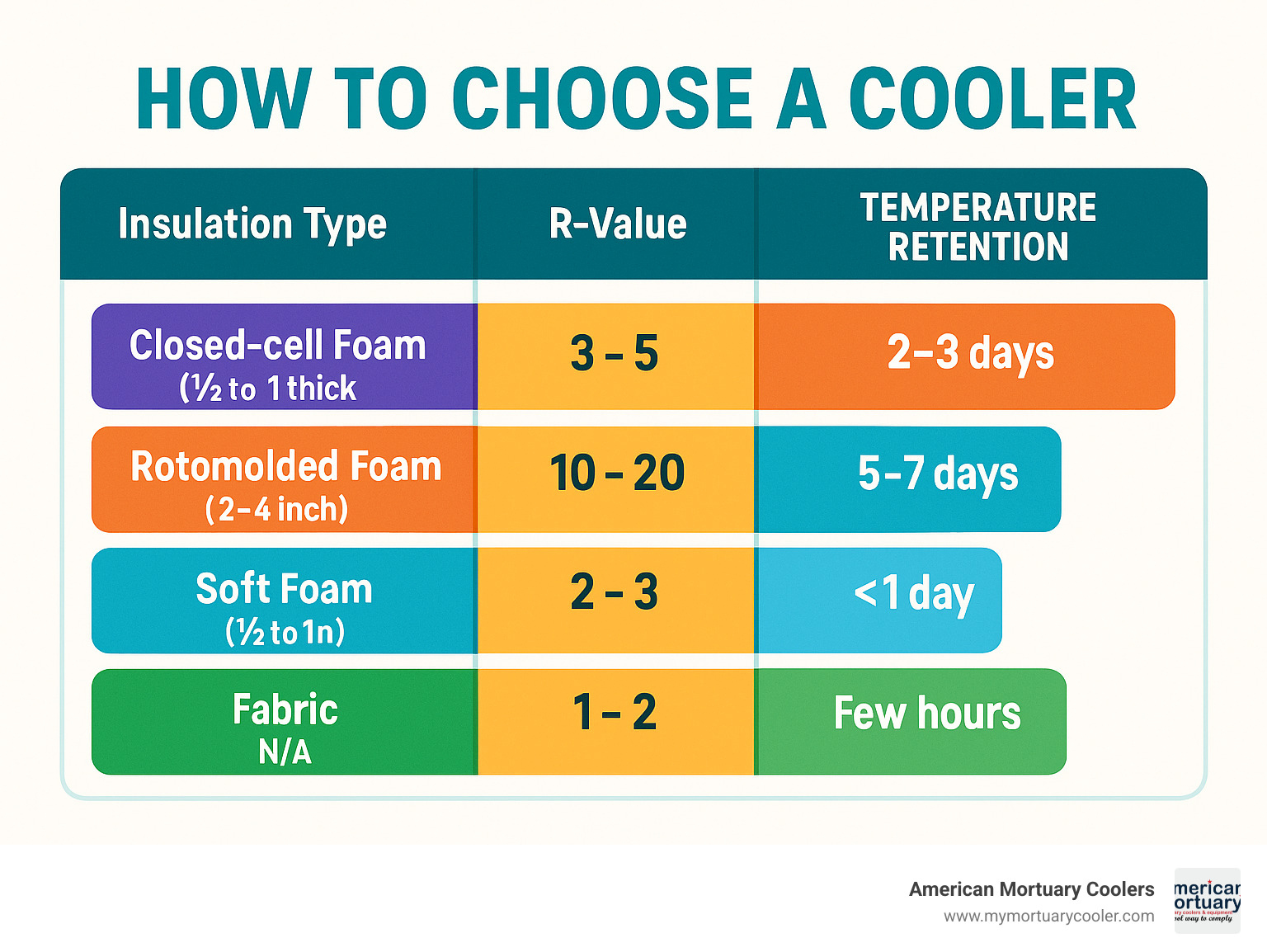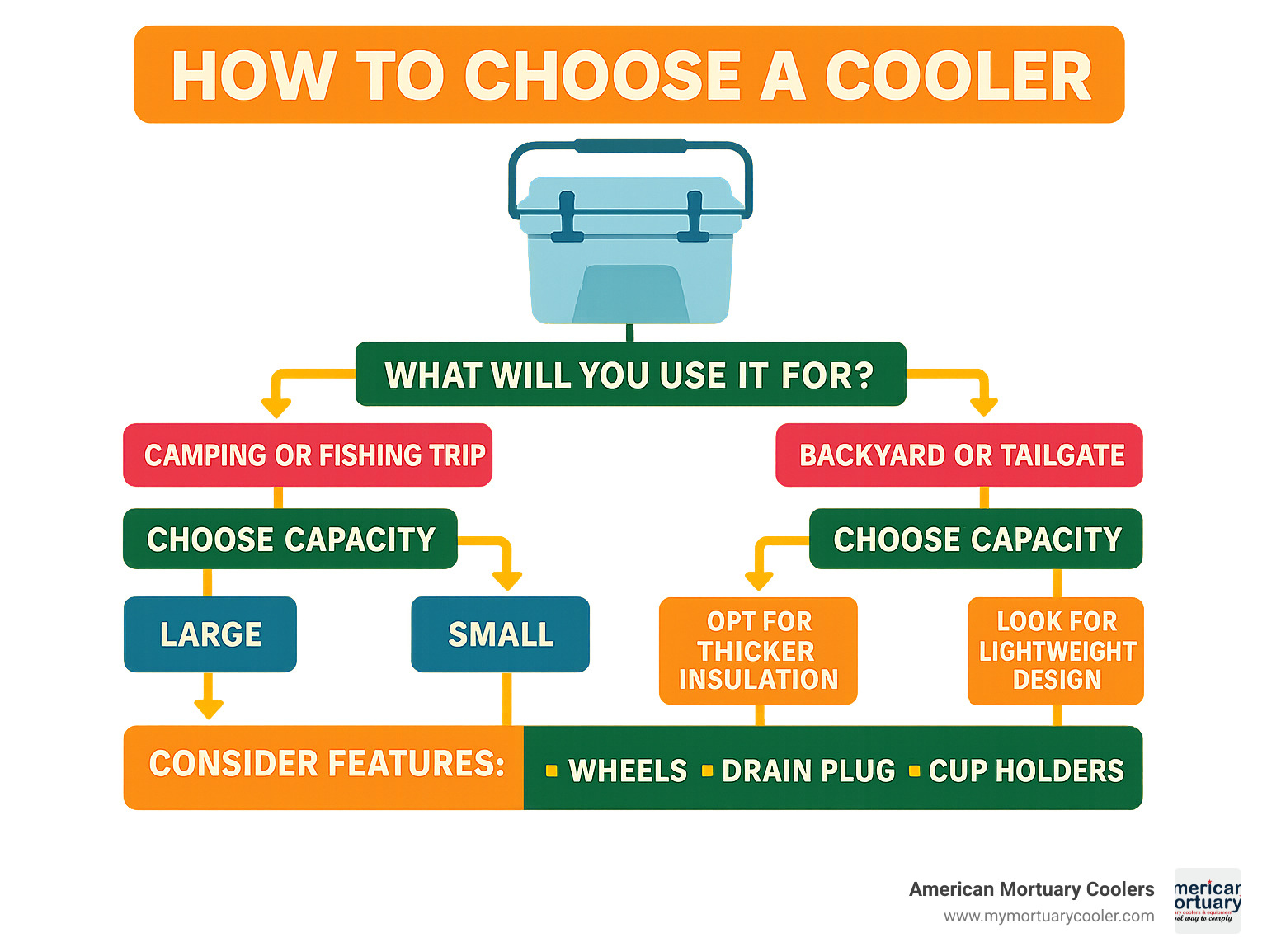How to Choose the Right Cooler for Your Needs
How to choose cooler depends on several key factors. Here's a quick guide to help you make the right decision:
- Determine your primary use (camping, beach, CPU cooling, mortuary, etc.)
- Consider capacity needs (personal, family, or commercial use)
- Evaluate insulation quality (affects ice retention time)
- Check portability features (wheels, handles, weight)
- Review additional features (drain plugs, bear resistance, etc.)
- Verify compatibility (with vehicles, spaces, or computer components)
- Compare durability and warranty (especially for commercial applications)
Choosing the right cooler can seem overwhelming with the vast array of options available today. Whether you're looking for a cooler for outdoor trips, computer components, or professional applications like mortuary services, understanding the key differences between types and features is essential.
The perfect cooler balances capacity, insulation performance, portability, and special features to match your specific needs. From hard-sided coolers that keep ice frozen for days to specialized mortuary units that maintain precise temperatures, each type serves a distinct purpose.
I'm Mortuary Cooler, with over a decade of experience helping funeral directors and outdoor enthusiasts alike find how to choose cooler options that perfectly match their requirements and budget constraints.

Basic How to choose cooler vocab:
Cooler Types 101: Hard, Soft, Electric & More

Let's break down the cooler world into digestible chunks. Think of this as your guide to understanding what's what in the cooling universe.
Hard vs. Soft Coolers – Pros & Cons
Hard-sided coolers are like reliable pickup trucks of the cooling world. They're built tough with thick plastic shells and serious insulation. Good ones can keep your ice frozen for 5-7 days. They're virtually indestructible, protect your contents well, and you can sit on them when camp chairs are taken!
The trade-off? Weight. Some weigh 30+ pounds empty. They're not compact, so trunk space can be an issue. Quality hard coolers typically command a higher price tag.
Soft coolers are the nimble athletes. They're lightweight with padded straps, and fold down for easy storage. Your wallet will usually thank you too, as they tend to be more budget-friendly.
The downsides? Ice retention is typically 24-48 hours max. They can't handle rough treatment like hard-sided coolers, and don't use one as a seat unless you enjoy surprise ice baths!
General rule: grab a soft cooler for day trips and light loads, but reach for a hard-sided model for multiple days when ice longevity matters.
Electric & Thermoelectric Coolers
Electric coolers are the tech-savvy members of the cooling family. Instead of melting ice, they use electricity to keep things chilled.
These plug into your vehicle's 12V outlet or standard household power. They maintain a steady temperature without the soggy sandwich syndrome from melting ice. Some models even double as warmers.
Premium models are essentially portable refrigerators, with some offering freezer capabilities. Size-wise, you'll find everything from compact 20-can models to 80-can options.
Electric coolers shine on road trips, for van life enthusiasts, or when you need to keep medications at specific temperatures. The drawback? They're usually pricier upfront and need power to work.
CPU & PC Coolers Snapshot
Switching gears - let's talk about keeping computers cool. While not for picnics, these cooling systems follow similar heat transfer principles.
The most common types are air coolers (tower-like arrangements of metal fins and fans) and AIO liquid coolers (closed-loop systems with radiators). For enthusiasts, there are custom water cooling loops.
The golden rule when choosing a computer cooler? Match the cooler's Thermal Design Power (TDP) rating to your processor's heat output. Check for socket compatibility with your motherboard, ensure it physically fits in your case, and consider noise levels.
How to Choose Cooler: Capacity, Insulation & Ice Retention
Figuring out the right cooler size and insulation quality is essential for keeping drinks cold and food safe. Let's break down the key factors.
Measuring Capacity in Quarts, Cans & Liters
Cooler capacity is typically listed in quarts (qt) in the US, though many brands include how many cans it holds or its liter capacity.
Here's a simple way to think about cooler sizes:
| Cooler Size (Quarts) | Approximate Can Capacity | Typical Use Case |
|---|---|---|
| 20-30 qt | 24-36 cans | Personal day trips, lunch for 1-2 people |
| 35-55 qt | 40-60 cans | Weekend trips for 2-3 people |
| 60-80 qt | 65-85 cans | Long weekends for 3-4 people |
| 90-125 qt | 95-130 cans | Extended trips or large groups |
Plan for about 10 quarts per person per day. This gives you enough space for both food and ice. Factor in your trip length, food container size, and ice needs.
Ideal Ice-to-Contents Ratio & Packing Tips
For weekend trips (2-3 days), aim for a 1:1 ratio – equal parts ice and contents. For longer trips (4+ days), use a 2:1 ratio (two parts ice to one part contents).
This means a weekend camping trip for four people requires roughly a 70-quart cooler – about 35 quarts for food and drinks and 35 quarts for ice.
To extend ice life, pre-chill your cooler before packing. Pre-chill food and drinks in the fridge overnight. Start with block ice or large frozen water bottles on the bottom, add regular ice, then food and drinks, filling gaps with more ice.
Keep your cooler in the shade and minimize opening it. Consider bringing a separate beverage cooler for frequently accessed items.
Insulation Tech: Rotomolded vs. Fabric Walls
High-end hard coolers typically feature rotomolded construction – creating seamless walls with consistent insulation thickness. These models often have 2-4 inches of pressure-injected foam, rubber gaskets for airtight seals, and lifted designs to minimize heat transfer.
Soft coolers use closed-cell foam (about ½ to 1 inch thick), multiple material layers including waterproof shells and food-grade liners, and sometimes thermal reflective layers. The best soft coolers include waterproof zippers to prevent air exchange.
This explains why high-end rotomolded coolers can maintain ice for 5-7 days, while even the best soft coolers typically max out around 2-3 days.
According to the USDA danger zone guidance, perishable foods must be kept at or below 40°F (4°C) to prevent bacterial growth – important when selecting coolers for longer trips.

Portability, Features & Compatibility
Even the most perfectly insulated cooler won't help if you can't get it where you need it. The right balance of portability features can make all the difference between a smooth experience and frustration.
Wheels, Handles & Weight Trade-Offs
Wheels become essential as cooler sizes increase. Pneumatic (air-filled) tires roll beautifully across sand and rough trails where regular plastic wheels might struggle. Larger wheel diameter handles obstacles better, while good ground clearance prevents getting stuck on uneven terrain.
For handles, you have options. Rope handles with rubber grips are lightweight but can dig into your hands with heavy loads. Rigid swing-up handles offer better ergonomics for heavy coolers. Large coolers should have molded side handles for two-person carrying.
Weight is often overlooked. An empty 30-pound rotomolded cooler becomes significantly heavier once loaded. Be realistic about your strength and carrying distance. Sometimes a smaller cooler you can manage is smarter than a larger one you'll struggle with.
Feature Checklist for Modern Coolers
A good drain plug is essential – it should be easy to open, allow complete drainage without awkward tilting, and ideally be tethered. Secure latches prevent spills during transport. Look for rubber latches that won't corrode, especially for marine use.
Non-slip feet keep your cooler in place on slick surfaces. UV-resistant materials prevent plastic from becoming brittle over time.
Useful additional features include internal dividers (keeping raw meat separate from ready-to-eat foods), dry storage bins (for phones and wallets), and built-in bottle openers. Boaters and off-roaders should look for tie-down points, while wilderness campers might need IGBC bear-resistant certification.
How to choose cooler for tight spaces & vehicles
Measure before buying! For recreational coolers, check your vehicle's cargo dimensions, accounting for other gear. Height restrictions matter if your cooler needs to fit under a tonneau cover. Boat and kayak owners should pay special attention to available storage spaces and tie-down accessibility.
PC builders face similar challenges. Verify socket compatibility between your motherboard and CPU cooler. Case clearance height is critical for tower air coolers – many builders have been disappointed when their side panel won't close. RAM clearance can also be an issue with larger air coolers.
For funeral industry professionals looking at walk-in or mortuary coolers, measure doorway dimensions to ensure your new unit can enter the building. Account for proper ventilation space, check floor load capacity, and plan electrical requirements in advance.
For more information about specialized mortuary cooler features, the Complete Guide to Walk-In Cooler Features and Prices offers valuable insights for funeral professionals.
Choosing a Cooler for Specific Activities
The perfect cooler for a beach day might be a disaster on a hiking trail. Let me walk you through how to choose cooler options for specific activities.
Camping, Beach & Fishing Essentials
For camping, prioritize models with 3-5 days of ice retention. In bear country, invest in a certified bear-resistant model.
Beach days require coolers with sand-capable wheels or comfortable carrying straps. Light colors reflect sunlight, keeping contents colder longer.
Fishing coolers need non-slip feet to stay put on rocking boats. Many fishing-specific models include built-in rulers and drain plugs that connect to garden hoses for easy cleaning. For saltwater use, look for marine-grade hardware to resist corrosion.
Parties & Tailgates – Serving the Crowd
For gatherings, think big – typically 40-100 quart capacity. Quick access features like dual-lid designs or separate compartments for frequently grabbed items are essential.
Built-in cup holders prevent spills, integrated bottle openers save searching, and cutting surfaces let you prep snacks right at your cooler.
According to the American Homebrewers Association beer-temp guide, most beers should be served around 45-50°F – slightly warmer than food-safe temperatures. Consider organizing your party cooler with beverages separate from food items.
Hiking & Backpacking Ultralight Picks
For trail trips, backpack coolers distribute weight across your shoulders and back. Look for ultralight models under 3 pounds empty with compact designs in the 12-24 quart range.
While these coolers typically maintain ice for only 24-48 hours, that's usually sufficient for overnight or weekend trips where weight matters more than extended cooling. Leak-proof construction is essential.
Mortuary & Walk-In Solutions
At American Mortuary Coolers, we understand that professional cooling needs differ from recreational ones. Funeral homes require cooling solutions with temperature precision that consistently maintains 35-40°F (2-4°C) for proper preservation.
Our professional-grade mortuary coolers feature redundant cooling systems, precisely calibrated temperature controls, and easy-access doors with safety releases. These units meet all relevant health regulations while maintaining energy efficiency.
Our walk-in coolers use extruded polystyrene insulation with exceptional long-term R-value retention – maintaining approximately 47% of its initial R-32 value throughout its lifespan, compared to just 19% for typical polyurethane alternatives.
For more information about features and pricing, check our guide on Walk-In Mortuary Cooler features.
PC Builders: How to choose cooler for your rig
When selecting a CPU cooler, socket compatibility is your starting point. Match your cooler's Thermal Design Power (TDP) rating to your processor's heat output. Verify clearances for RAM, case dimensions, and motherboard components.
Balancing cooling performance and noise levels is often more important than maximum cooling potential. Air coolers typically offer the best value for most users, while liquid AIO coolers provide superior cooling for high-performance systems and overclocking.
Frequently Asked Questions about How to Choose Cooler
What size cooler is best for a weekend trip?
For a weekend getaway (2-3 days), size your cooler based on group size:
Solo travelers: A 25-35 quart cooler is perfect—enough room for personal meals and beverages without excess weight.
Couples should consider 35-45 quart models, providing space for shared meals without taking up too much trunk space.
Family trips require 60-70 quart coolers for a family of four, with room for everyone's favorites and sufficient ice.
These recommendations assume you're packing both food and drinks with proper ice. If you're just cooling beverages or can restock ice, you might manage with something smaller.
Tip: Larger coolers maintain ice longer due to more insulation relative to surface area. When deciding between sizes, the bigger option will likely keep things colder longer.
What's the perfect ice-to-contents ratio?
Your trip duration should guide your ice strategy:
Day trips: 1:2 ratio (one part ice to two parts food/drinks)
Weekend trips: 1:1 balance (equal parts ice and contents)
Extended journeys (4+ days): 2:1 ratio (two parts ice to one part contents)
Create a "cooling foundation" with block ice or frozen water bottles on the bottom, then surround food and drinks with cubed ice. Pre-chilling both your cooler and contents can reduce ice melt by up to 30%.
How do I ensure my CPU cooler fits my case?
Follow this compatibility checklist:
Check your case specifications for maximum cooler height (air coolers) or available radiator mounting positions (liquid cooling)
Verify the cooler is compatible with your motherboard's CPU socket
For tower-style air coolers, measure clearance to RAM slots and other motherboard components
Liquid cooler users should confirm that radiator thickness plus fans will fit in your chosen mounting location
Check reviews from users with your specific motherboard and case combination
Many cooler manufacturers provide online compatibility tools to help narrow down options based on your specific hardware.
Conclusion

When it comes down to it, how to choose cooler options really boils down to understanding what matters for your specific situation. The right fit makes all the difference!
The perfect cooler strikes that sweet spot between what you need and what you can practically manage. For weekend warriors, this might mean prioritizing ice retention and durability. For PC builders, it's balancing cooling performance with noise levels. For funeral homes, precision temperature control and reliability are non-negotiable.
Capacity should match your actual usage patterns. There's nothing worse than lugging around an enormous cooler when a compact one would suffice – or realizing your cooler is too small halfway through your trip.
Insulation quality is the heart of any good cooler. Those thick rotomolded walls keep your ice from becoming a lukewarm puddle by lunchtime. The best coolers create a microclimate that maintains safe temperatures for days.
Don't overlook portability features. Those heavy-duty wheels might seem unnecessary until you're dragging 50 pounds of ice and food across a beach!
Here at American Mortuary Coolers, we apply these same principles when designing custom cooling solutions for funeral homes nationwide. Our years of experience with professional-grade temperature control systems have taught us that good cooling design fundamentals remain consistent whether for a family picnic or essential mortuary services.
For those with professional mortuary needs, we offer direct delivery and expert installation throughout the contiguous 48 states. Our strategically located facilities in Tennessee and regional centers in major cities ensure prompt service regardless of your location.

The best cooler isn't necessarily the most expensive or feature-packed option – it's the one that reliably meets your specific needs. By considering the factors outlined in this guide, you'll be well-equipped to make a choice you won't regret. And if you're in the funeral industry looking for specialized cooling solutions, you'll find everything you need at your one-stop shop for mortuary coolers.
Now you're ready to chill harder than in the Ice Age! Whether preserving memories on an outdoor trip or providing essential funeral services, the right cooler makes all the difference. Stay cool, friends!



















